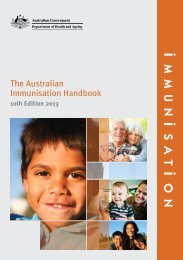Contents Chapter Topic Page Neonatology Respiratory Cardiology
Contents Chapter Topic Page Neonatology Respiratory Cardiology
Contents Chapter Topic Page Neonatology Respiratory Cardiology
You also want an ePaper? Increase the reach of your titles
YUMPU automatically turns print PDFs into web optimized ePapers that Google loves.
distance of the light source from the baby, the optimum distance being 35 - 50 cm in<br />
conventional lights.<br />
Types of photolights<br />
Conventional phototherapy<br />
Fibre optic phototherapy (Biliblanket)<br />
Intensified phototherapy<br />
In cases of mild to moderate jaundice conventional and fibre optic phototherapy usually<br />
suffice but where jaundice is significantly high (e.g. >300 umol/L in a 5 day old or 250<br />
umol/L in a 24 hour old infant ) intensified phototherapy should be used.<br />
The methods of providing intensified phototherapy are as follows:<br />
i. high intensity blue lights ( F20 T12 / BB ) with 7 overhead lamps, and 4 lamps<br />
placed below the infant.<br />
ii. combined fibreoptic blanket with standard phototherapy system above, thus<br />
increasing the surface area of the infant exposed to light.<br />
iii. several phototherapy lamps placed around the infant, if a fibreoptic unit is not<br />
available.<br />
iv. placing a white reflecting surface (e.g. sheet) around the bassinet, so that light is<br />
reflected onto the baby's skin when using a single phototherapy unit so as to<br />
increase the area of exposure.<br />
Phototherapy : Practical considerations.<br />
Position light source 35-50 cm from top surface of the infant (when conventional<br />
fluorescent photolights are used.)<br />
Expose infant appropriately<br />
Cover infant's eyes<br />
Turn infant every 2 hours<br />
Monitor serum bilirubin levels as indicated<br />
Monitor infant's temperature 4 hourly to avoid chilling or overheating<br />
Allow parental-infant interaction<br />
Discontinue phototherapy when bilirubin is less than threshold levels and has been<br />
falling for 24 hours. In infants without haemolytic disease, the average bilirubin<br />
rebound after phototherapy is less than 1 mg/dl (17 µmol/dl). Discharge from hospital<br />
need not be delayed in order to observe the infant for rebound, and in most cases,<br />
no further measurement of bilirubin is necessary. However, if phototherapy is<br />
initiated early and discontinued before the infant is 3 to 4 days old, additional<br />
ambulatory follow-up may be necessary<br />
Measure intensity of phototherapy light periodically using irradiance meters<br />
Turn off light during feeding and blood taking<br />
Hydration- there is no evidence to support any influence of excess fluid<br />
administration on serum bilirubin concentration. Some infants admitted with high<br />
bilirubin levels may also be mildly dehydrated, and may need fluid supplementation.<br />
More frequent breastfeeding is recommended because it inhibits the enterohepatic<br />
circulation of bilirubin and thus lowers the serum bilirubin level. Other routine<br />
supplementation e.g. with dextrose water is not indicated
















